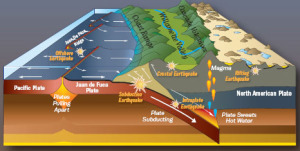January 26, 2015 marked the 315th anniversary of the Great 1700 Cascadia Subduction Zone (CSZ) Earthquake and Tsunami. The Pacific Northwest experienced the 1700 Cascadia earthquake and tsunami which had an impact as far away as Japan. Geological evidence indicates that such great earthquakes have occurred at least seven times in the last 3,500 years, a reoccurrence interval of 300 to 600 years. The next major CSZ earthquake could strike the PNW at any time.
Imagine, thousands of coastal residents settling in for the night on January 26th 1700 when the ground began to shake. For most, the first signs were subtle, dogs barked nervously as the primary or “P” wave vibrations passed by. The earthquake became unmistakable when the “S” (secondary or shear) waves arrived at village after village traveling at about 3.7 miles a second as the entire Cascadia Subduction Zone ruptured. The 600-700 mile long fault rupture propagated from its origin at almost 2 miles a second, generating fresh seismic waves as the fault continued to unzip and slip. Assuming the rupture began in Northern California, it likely took over 5 minutes break the entire fault to northern Vancouver Island.
The earthquake that released about 1500 times the seismic energy than the 2001 M 6.8 Nisqually Earthquake, and can be seen as a connected series of large earthquakes at least one of which produced very low frequency waves with 10s of meters of displacement, and a dramatic popping up of the sea floor that lifted a great column of water. That uplifted column of water then collapsed producing a series of tsunami waves that would batter the coastline through the night and cross the pacific basin. Though all people west of the Cascades were disrupted by the shaking and some injured by falling logs and possessions, it was the water that likely claimed the hundreds of lives lost that night when villages were overtopped by tsunami generated floods.
The 1980s was a decade of discovery of evidence for great earthquakes in the Cascadia Region. Tom Heaton and Hiroo Kanamori published a paper asserting the Cascadia Subduction Zone was indeed actively deforming and is likely to produce great earthquakes. Brian Atwater’s 1987 paper in Science provided the necessary “ground truthing” of these theories describing repeated abrupt co-seismic land level changes along our coast and evidence of tsunami inundation following periodic great earthquakes. Atwater with many scientific colleagues continued to work over decades to tease out the details of magnitude, shaking levels, tsunami hazards, and reoccurrence rate of great Cascadia earthquakes. This work also involved the study of earthquakes in other subduction zones around the world and provided the precise date and even the hour of the 1700 earthquake derived from the arrival time of the Cascadia Tsunami in Japan. We now know a ~magnitude 9 earthquake struck our region on January 26, 1700 at ~9:00 PM. We also know the fault is reloaded with strain and capable of producing another great earthquake today though it is probable that we have many decades with which to prepare for this inevitable earthquake.
Scientists have had many examples of these subduction zone earthquakes to study over the past 10 years as hundreds of thousands of people have died in great earthquakes and the tsunami waves they produced. The largest of these, the Mw 9.1 2004 Sumatra-Andaman Earthquake and Indian Ocean Tsunami killed between 230 and 300 thousand people in Indonesia and at least 15 other nations. A dozen other great earthquakes occurred over the past 10 years including the 2010 M 8.8 Maule, Chile Earthquake and the Great East Japan Earthquake of March 11, 2011 in which over 15,000 Japanese died, over 92% from drowning during the tsunami flooding.
The Cascadia Subduction Zone has remained locked, loaded, and quiet through all this tumult. It does not even produce the small earthquakes so prevalent in other subduction zones around the world. The Cascadia Subduction Zone behaves differently than all other subduction zones on the planet. Scientists also see significant variation in behavior from one subduction zone to the next so it is hard to know what lessons should we learn from these earthquakes to lower our losses when our fault breaks loose again. Despite the natural variations between faults and earthquake effects, some clear conclusions can be made.
Emergency response will be slow and households, particularly in rural and coastal areas, need to be self-sufficient for food, water, and medicine for weeks, not just days. It is not realistic to think that the millions of people impacted by this regional event will receive assistance within 72 hours of the earthquake. Unfortunately, only a minority of households have the old 3 day minimum of disaster supplies on hand. We must set aside more.
Tsunami waves kill. Many coastal areas have been identified where no tsunami safe evacuation options are available. Engineering design standards have been adopted and community planning initiated for vertical evacuation berms and structures. Support for construction of vertical evacuation alternatives must be obtained and work to build examples of safe evacuation options should begin.
Without power and fuel communities cannot begin to recover and even critical services such as police, fire, and hospitals are degraded when adequate fuel is not available.
Energy companies and agencies in the Cascadia region should make investments necessary to develop a resilient energy infrastructure through strengthening the transmission networks for electricity, liquid fuels, and natural gas to prevent catastrophic damage in a future Cascadia earthquake. Moderate investments in these critical systems can produce enormous future savings and a platform from which to drive recovery. This is a National economic issue and should be treated as such in the Federal and State policy arenas to help make these investments possible.
Credit to Gordon McGraw and the Pacific Northwest Seismic Network for this information.

